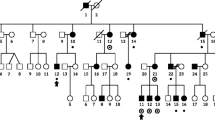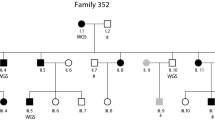Abstract
Recently, DYX1C1, a candidate gene for developmental dyslexia, encoding a nuclear tetratricopepetide repeat domain protein dynamically regulated in brain, has been characterized through a translocation breakpoint in a Finnish family. Two putatively functional variants, −3G/A and 1249G/T, have been reported to be significantly associated with dyslexia in this population. Further studies, conducted on different ethnic groups (English and Canadian), have not confirmed a role for DYX1C1 variants in increasing the risk for dyslexia. We investigated the role of these variants in dyslexic children and adolescents from Southern Italy. No significant evidence for association between dyslexia and these DYX1C1 putative functional variants has been shown. We argue that the different DYX1C allele frequencies shown among Italian and Finnish subjects with dyslexia could be attributable to the different linkage disequilibrium structure of these populations.
Similar content being viewed by others
References
American Psychiatric Association (1994) Diagnostic and Statistical Manual of Mental Disorders, 4th ed., Washington, D.C.
Cope N. A., Hill G., van den Bree M., Harold D., Moskvina V., Green E. K., et al. (2004) No support for association between Dyslexia Susceptibility 1 Candidate 1 and developmental dyslexia. Mol. Psychiatry. 10, 237–238. [Epub ahead of print].
Cornoldi C., Colpo G., and MT Group (1986) Prove di Lettura, Organizzazioni Speciali, Florence, Italy.
de Kovel C. G. F., Hol F. A., Heister J. G. A. M., Willemen J. J. H. T., Sandkuijl L. A., Franke B., and Padberg G. W. (2004) Genomewide scan identifies susceptibility locus for dyslexia on Xq27 in an extended Dutch family. J. Med. Genet. 41, 652–657.
Demonet J. F., Taylor M. J., and Chaix Y. (2004) Developmental dyslexia. Lancet 363, 1451–1460.
Fagerheim T., Raeymaekers P., Tonnessen F. E., Pedersen M., Tranebjaerg L., and Lubs H. A. (1999) A new gene (DYX3) for dyslexia is located on chromosome 2. J. Med. Genet. 36, 664–669.
Fisher S. E., Francks C., Marlow A. J., MacPhie I. L., Newbury D. F., Cardon L. R., et al. (2002) Independent genomewide scans identify a chromosome 18 quantitative-trait locus influencing dyslexia. Nat. Genet. 30, 86–91.
Francks C., Fisher S. E., Olson R. K., Pennington B. F., Smith S. D., DeFries J. C., and Monaco A. P. (2002) Fine mapping of the chromosome 2p12–16 dyslexia susceptibility locus: quantitative association analysis and positional candidate genes SEMA4F and OTX1. Psychiatr. Genet. 12, 35–41.
Grigorenko E. L. (2003) The first candidate gene for dyslexia: turning the page of a new chapter of research. Proc. Natl. Acad. Sci. U. S. A. 100, 11,190–11,192.
Grigorenko E. L., Wood F. B., Meyer M. S., Pauls J. E., Hart L. A., and Pauls D. L. (2001) Linkage studies suggest a possible locus for developmental dyslexia on chromosome 1p. Am. J. Med. Genet. 105, 120–129.
Hsiung G. Y., Kaplan B. J., Petryshen T. L., Lu S., and Field L. L. (2004) A dyslexia susceptibility locus (DYX7) linked to dopamine D4 receptor (DRD4) region on chromosome 11p15.5. Am. J. Med. Genet. 125B, 112–119.
Laan M., Wiebe V., Khusnutdinova E., Remm M., and Paabo S. (2004) X-chromosome as a marker for population history: linkage disequilibrium and haplotype study in Eurasian populations. Eur. J. Hum. Genet. 13, 452–462. [Epub ahead of print].
Lindgren S. D., De Renzi E., and Richman L. C. (1985) Cross-national comparisons of developmental dyslexia in Italy and the United States. Child Dev. 56, 1404–1417.
Marino C., Giorda R., Vanzin L., Nobile M., Lorusso M. L., Baschirotto C., et al. (2004) A locus on 15q15-15qter influences dyslexia: further support from a transmission/disequilibrium study in an Italian speaking population. J. Med. Genet. 41, 42–46.
Morris D. W., Ivanov D., Robinson L., Williams N., Stevenson J., Owen M. J., et al. (2004) Association analysis of two candidate phospholipase genes that map to the chromosome 15q15.1–15.3 region associated with reading disability. Am. J. Med. Genet. 129B, 97–103.
Nopola-Hemmi J., Myllyluoma B., Haltia T., Taipale M., Ollikainen V., Ahonen T., et al. (2001) A dominant gene for developmental dyslexia on chromosome 3. J. Med. Genet. 38, 658–664.
Paulesu E., Demonet J. F., Fazio F., McCrory E., Chanoine V., Brunswick N., et al. (2001) Dyslexia: cultural diversity and biological unity. Science 291, 2165–2167.
Pennington B. F. (1990) The genetics of dyslexia. J. Child Psychol. Psychiatry 31, 193–201.
Petryshen T. L., Kaplan B. J., Hughes M. L., Tzenova J., and Field L. L. (2002) Supportive evidence for the DYX3 dyslexia susceptibility gene in Canadian families. J. Med. Genet. 39, 125–126.
Rabin M., Wen X. L., Hepburn M., Lubs H. A., Feldman E., and Duara R. (1993) Suggestive linkage of developmental dyslexia to chromosome 1p34–p36. Lancet 342, 178.
Scerri T. S., Fisher S. E., Francks C., MacPhie I. L., Paracchini S., Richardson A. J., et al. (2004) Putative functional alleles of DYX1C1 are not associated with dyslexia susceptibility in a large sample of sibling pairs from the UK. J. Med. Genet. 41, 853–857.
Schulte-Korne G. (2001) Annotation: genetics of reading and spelling disorder. J. Child Psychol. Psychiatry 42, 985–997.
Taipale M., Kaminen N., Nopola-Hemmi J., Haltia T., Myllyluoma B., Lyytinen H., et al. (2003) A candidate gene for developmental dyslexia encodes a nuclear tetratricopeptide repeat domain protein dynamically regulated in brain. Proc. Natl. Acad. Sci. U. S. A. 100, 11,553–11,558.
Wechsler D. (1981) Examiner’s Manual. Wechsler Intelligence Scale for Children, rev ed. Psychological Corp., New York.
WHO (1993) The International Classification of Diseases, vol. 10: Classification of Mental and Behavioural Disorders, World Health Organization, Geneva, Switzerland.
Wigg K. G., Couto J. M., Feng Y., Anderson B., Cate-Carter T. D., Macciardi F., et al. (2004) Support for EKN1 as the susceptibility locus for dyslexia on 15q21. Mol. Psychiatry 9, 1111–1121.
Author information
Authors and Affiliations
Corresponding author
Rights and permissions
About this article
Cite this article
Bellini, G., Bravaccio, C., Calamoneri, F. et al. No evidence for association between dyslexia and DYX1C1 functional variants in a group of children and adolescents from Southern Italy. J Mol Neurosci 27, 311–314 (2005). https://doi.org/10.1385/JMN:27:3:311
Received:
Accepted:
Issue Date:
DOI: https://doi.org/10.1385/JMN:27:3:311




